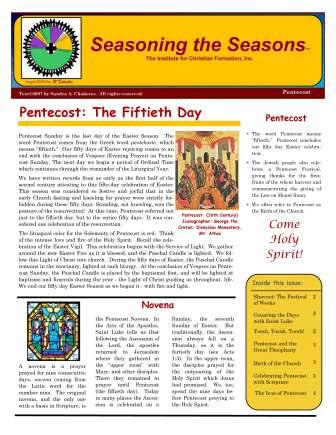The Institute for Christian Formation
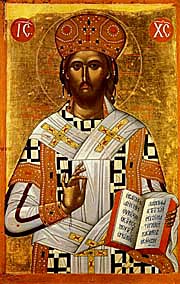
Pentecost
Follow us on Facebook to keep up to date with our news and newest resources!
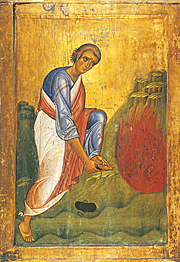
Prophet Moses Before the Burning Bush, 13th Century
St. Catherine’s Monastery,
Mt. Sinai
St. Luke the Evangelist
16th Century, Russian
Location: Andrei Rublev Museum, Moscow
Pentecost
Iconographer: George the Cretan
Location: Dionysiou Monastery,
Mt. Athos, Greece
Luke the Evangelist, the author of one of our four Gospels, is also the author of the Acts of the Apostles. The Acts of the Apostles gives us the account of Pentecost, as well as the time-line of events (Resurrection, Ascension and Pentecost) as celebrated in our Liturgical Calendar. Acts 1:3 refers to “forty days”, the fortieth day being the traditional date for celebrating the Ascension. (Many dioceses now celebrate the Ascension on the Sunday before Pentecost Sunday – the Seventh Sunday of Easter - rather than on a Thursday.) Acts 2:1 refers to the time of Pentecost, which would be the fiftieth day, the time the Jews were celebrating the first-fruits of the wheat harvest.
A close reading of the four Gospels does not reveal this time frame that Luke gives us in the Acts of the
Pentecost - the 50th Day
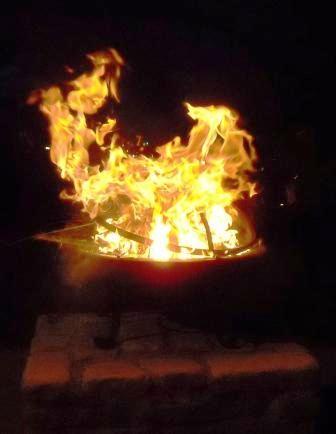
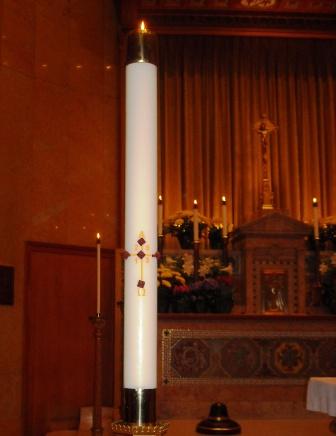
Pentecost Sunday is the last day of the Easter Season. The word Pentecost comes from the Greek word pentekoste, which means “fiftieth.” Our fifty days of Easter rejoicing comes to an end with the conclusion of Vespers (Evening Prayer) on Pentecost Sunday. The next day we begin a period of Ordinal Time which continues through the remainder of the Liturgical Year.
We have written records from as early as the first half of the second century attesting to this fifty-day celebration of Easter. This season
was considered so festive and joyful that in the early Church fasting and kneeling for prayer were strictly forbidden during these fifty days. Standing, not kneeling, was the posture of the resurrection! At this time, Pentecost referred not just to the fiftieth day, but to the entire fifty days. It was considered one celebration of the resurrection.
The liturgical color for the Solemnity of Pentecost is red. Think of the intense love and fire of the Holy Spirit. Recall the celebration of the Easter Vigil. This celebration begins with the Service of Light. We gather around the new Easter Fire as it is blessed, and the Paschal Candle is lighted. We follow this Light of Christ into church. During the fifty days of Easter, the Paschal Candle remains in the sanctuary, lighted at each liturgy. At the conclusion of Vespers on Pentecost Sunday, the Paschal Candle is placed by the baptismal font, and will be lighted at baptisms and funerals during the year - the Light of Christ guiding us throughout life. We end our fifty day Easter Season as we began it - with fire and light.
Novena
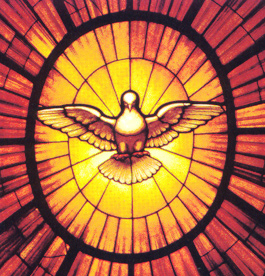
Dove of the Holy Spirit
Gian Lorenzo Bernini, ca. 1660
stained glass
Throne of St. Peter
St. Peter's Basilica, Vatican
A novena is a prayer prayed for nine consecutive days, novena coming from the Latin word for the number nine. The original novena, and the only one with a basis in Scripture, is the Pentecost Novena. In the Acts of the Apostles, Saint Luke tells us that following the Ascension of the Lord, the apostles returned to Jerusalem where they gathered in the “upper room” with Mary, and other disciples. There they remained in prayer until Pentecost (the fiftieth day). Today in many places the Ascension is celebrated on a Sunday, the seventh Sunday of Easter. But traditionally, the Ascension always fell on a Thursday, as it is the fortieth day (see Acts 1:3). In the upper room, the disciples
prayed for the outpouring of the Holy Spirit which Jesus had promised. We, too, spend the nine days before Pentecost praying to the Holy Spirit.
In our current Liturgical year, begin your Pentecost Novena on Friday, May 14, 2021 and conclude it on Saturday, May 22, 2021.
Come, Holy Spirit, fill the hearts of your faithful,
and enkindle in them the fire of your love.
Send forth your Spirit, and they shall be created,
and you shall renew the face of the earth.
You can download a Pentecost Novena prayer brochure, to use for prayer during the nine days leading up to Pentecost, from the Liturgy Office of England and Wales, here.
Shavuot: The Festival of Weeks
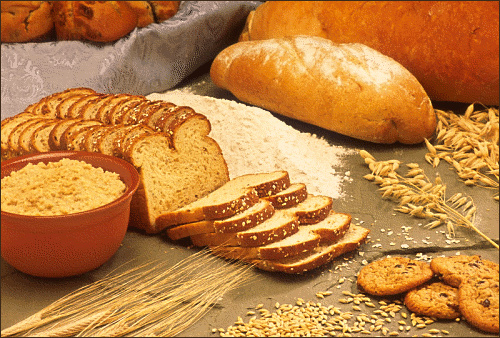
Fifty days after we celebrate the resurrection, Jesus' passover from death to new life, we conclude the Easter Season with the celebration of Pentecost. The Jewish people also have a Pentecost celebration. Fifty days after the celebration of Passover, the Jewish people celebrate the Festival of Weeks, or Shavuot. "Shavuot" means “weeks” in Hebrew. Shavuot is a
harvest festival. It is a celebration of the first-fruits of the wheat harvest. You can read about this Jewish celebration of Shavuot, or Pentecost, in the Hebrew Scriptures (see, for example, Leviticus 23:15ff).
In I Corinthians 15:20, Saint Paul refers to Jesus as the “first-fruits” of those who have died. Jesus conquered death and paved the way for the rest of humanity to also conquer death and share in eternal life.
Fifty days after we celebrate the resurrection of Jesus, we celebrate the outpouring of the Holy Spirit at Pentecost. As part of their celebration of Pentecost, or Shavuot, the Jewish people offered freshly baked bread in celebration of the wheat harvest. The power of the Spirit gathers us together to celebrate the Eucharist, where the bread we consume is the Body of Christ. Reflect upon John 12:24, where Jesus talks about a grain of wheat dying and producing fruit. The outpouring of the Holy Spirit is the fulfillment of the Paschal Mystery.
Counting the Days with Luke
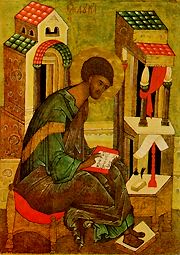
Apostles. In fact, if you read John 20:19-23, John’s account has Jesus giving the Holy Spirit to his disciples on the evening of the same day he rose from the dead. Yet as we have seen, the symbolism of fifty days, and the fiftieth day, is very powerful indeed!
Torah! Torah! Torah!

Pentecost, the fiftieth day, Shavuot (the Festival of Weeks), has even more significance to the Jewish people than we have already noted. Recall when the Israelites were led out of Egypt, experiencing their Passover from slavery to freedom. After leaving Egypt, it took them fifty days to get to Mount Sinai, where they received the Torah, the Law. Therefore, at the Festival of Shavuot, the Jewish people also celebrate the great gift of the Torah.
Notice how the fiftieth day keeps coming into play. It is fifty days after the Jewish people “pass over” from slavery to freedom that they receive the Law. It is fifty days after Jesus passes over from death to life in the resurrection that the disciples receive the Holy Spirit.
Seven is a perfect number in Scripture. It comes up time and time again and is very symbolic. Just think of a few examples. Genesis 2:2 tells us that God’s work of creation was completed in six days, and on the seventh day God rested. The seventh day is the Sabbath. There is the seven-fold gift of the Holy Spirit. We have seven sacraments in the Catholic Church. There are seven days in a week. Seven weeks is forty-nine days, and then to make things even more perfect, we get a fiftieth day! A week of weeks, Shavuot - the Festival of Weeks, Pentecost the Fiftieth Day!
Pentecost and the Great Theophany
Exodus 19 gives us an account of the covenant between God and the Israelites at Mount Sinai. 19:16ff tells of the great Theophany. Read this account. How is God revealed or made known? There is smoke and fire and thunder. The mountain, itself, is trembling. Trumpets are blaring. Now read the account of Pentecost in Acts chapter 2. How does the Holy Spirit descend upon the disciples? There is a loud noise like a strong wind. There are tongues of fire. Do you see the similarities? The Holy Spirit is the Third Person of the Holy Trinity. The Holy Spirit is God. And when God reveals God’s self, this revelation is often accompanied by smoke, and fire, and trumpet blasts, and wind. (Recall Moses and the Burning Bush!)
The word used in the Hebrew Scriptures is “ruah”,
which in Hebrew means wind or breath. Perhaps that is why today so many people in various countries around the world celebrate Pentecost with activities involving the wind. They fly kites, and sail boats, and make music with wind chimes. Just as we cannot “see” the wind, but we can see its effects (a kite flying, the sound of wind chimes, a cool breeze on a hot summer day), so too, we cannot “see” the Holy Spirit, but the effects of the Spirit’s presence are very noticeable - they are the Fruit of the Holy Spirit. In Galatians 5:22-23, Saint Paul lists these fruit of the Spirit. And now we have yet another connection to Pentecost being a harvest festival of first-fruits!
Birth of the Church
Pentecost is often referred to as the “Birth of the Church.” This is true. But it is important to remember that Pentecost is the fiftieth and final day of the Easter Season. The gift of the Holy Spirit is the fulfillment of the Paschal Mystery. Jesus suffered and died, rose from the dead, ascended into Spirit-filled glory, and gave the Church the promised gift of the Holy Spirit.
It is by the gift of the Spirit that we live in community - that we live as the Body of Christ, the Church. Read Acts 2:42ff. After Peter’s speech at Pentecost, the disciples devoted themselves to communal life - to teaching the faith and celebrating the Eucharist. Thus the Church was born and grew. Today we, too, receive the Holy Spirit to continue the mission of the Church.
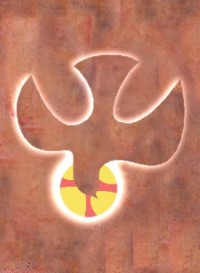
In the very beginning, Genesis 1:2 talks about the wind over the waters as God began creation. This word for wind is the Hebrew word “ruah”, which also means breath. In John’s Gospel, Jesus breathes on the apostles and they receive the Holy Spirit (John 20:22). The Spirit makes things new. The Spirit draws us into community. The Spirit gathers us together to celebrate the Eucharist. So, yes, it is very fitting that we celebrate Pentecost, the fiftieth day, as the fulfillment of the Paschal Mystery and the birth of the Church!
Celebrating Pentecost with Scripture
The Scripture readings assigned to the celebration of Pentecost are very rich. And there are some options available as to the selection of these readings. But here they are all listed. Spend some time preparing for Pentecost by prayerfully reading and reflecting upon each passage!
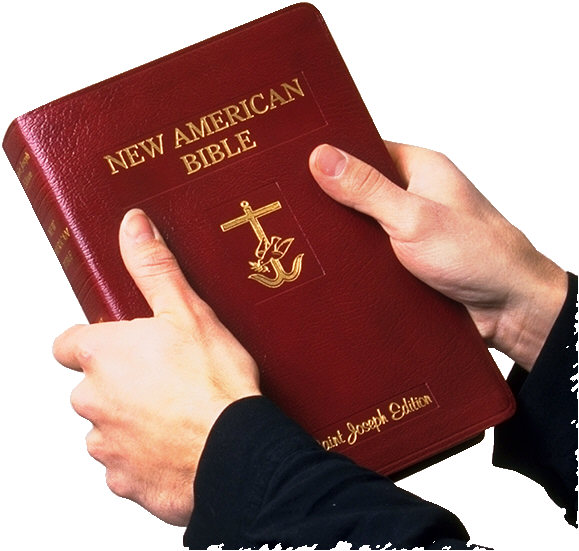
For the Vigil of Pentecost, there are four options for the first reading: Genesis 11:1-9; Exodus 19:3-8a,16-20b; Ezekiel 37:1-14; and, Joel 3:1-5. An interesting point is that this is the first time since the Easter Vigil that we hear readings from the Hebrew Scriptures. During the Easter Season, our first reading at Mass has been from the Acts of the Apostles rather than the Hebrew Scriptures. The second reading for the Pentecost Vigil is Romans 8:22-27. The Gospel is John 7:37-39.
On the day of Pentecost, the first reading is Acts 2:1-11. There is a choice for the second reading: 1 Corinthians 12:3b-7,12-13 or Romans 8:8-17. And there is also a choice of Gospel readings: John 20:19-23 or John 14:15-16,23b-26.
What insight does each of these readings give us into the celebration and meaning of Pentecost? Why do you think each was selected? Ponder the Word of God, and ask the Holy Spirit to enlighten your reading of the Scriptures!
The Icon of Pentecost
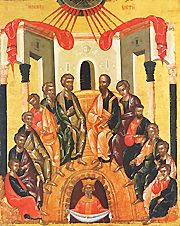
Icons tell us a story without using words. A traditional icon of the Descent of the Holy Spirit appears here. This icon dates from the 16th century. We will look at a few details of this icon to better understand the symbolism of the icon, as well as the feast of Pentecost, itself.
You will notice that there are twelve apostles in this icon. Twelve is a symbolic number. What is interesting to note, however, is that the two apostles at the top of the icon are Peter and Paul. Why is this interesting? If you read the Acts of the Apostles, you will note that Paul would not have been present at Pentecost. At this time he was still “Saul”, not yet having his personal experience of Jesus on the road to Damascus. In fact, in Acts 1:
26, just before the outpouring of the Spirit, the apostles chose Matthias to replace Judas, who killed himself after his betrayal of Jesus. But the iconographers include Saint Paul, because of his great missionary efforts in establishing the Church.
You will also note that the apostles appear to have their heads turned in differing directions, symbolizing the different yet equal charism which each has received from the Holy Spirit. Note the rays of the Holy Spirit coming down from above, and descending as tongues of fire over each of the apostles. The apostles are each holding scrolls or Books of the Gospels, indicating their teaching authority, given to them by Christ.
Who is the elderly king in the darkness at the bottom of the icon? He is “cosmos”, representing the world held captive in darkness until the coming of Christ. He is holding a cloth with twelve scrolls which represent the Good News the apostles will share with the world as they spread the Light of Christ through their preaching and missionary journeys. This Light of Christ has been handed down generation after generation to us, and gifted by the Spirit, we too share this Light of Christ with the world!
Click on image above to download our 4-page ICF adult/teen Pentecost bulletin.
Celebrating Pentecost with Children
•Children love drama! Share the story of Pentecost with children and then invite them to role-play this Scripture passage.
•Make a Pentecost mobile. This can be as simple as cutting out “flame” shapes from red paper and/or “dove” shapes from white paper, decorating these, and hanging them from a dowel rod or a hanger.
•Invite children to decorate a Pentecost card and write a prayer to the Holy Spirit on the inside. Let them decide who will receive the card(s).
•Invite children to make a kite and decorate it with symbols of Pentecost (doves, flames, red streamers, etc.). If the weather cooperates, enjoy a kite flying expedition on Pentecost – or the days leading up to it!
•Let children create a Pentecost mural or icon.
•Here is a link to a Pentecost coloring page.

A Pentecost Dinner Table
•The traditional Italian Easter bread, “Colomba Pasquale”, which translates as “Easter Dove” as the bread is traditionally baked in the shape of a dove, is a great addition to your Pentecost Sunday dinner table. Learn more and find the recipe here.
•Make a Pentecost cake – perhaps a red velvet cake with white icing, decorated with red flames and golden doves.
•Serve a fruit cake or fruit bread and discuss the Fruit of the Holy Spirit.
•Make a fruit salad using various fruits.

•Make and decorate dove shaped cookies.
•Set your table with a bright red tablecloth. For your centerpiece have a vase of peonies, the Pentecost flower!
•Make sure you have candles lighted on your table, as well as a lovely bowl filled with Easter Water from the font at church.
•At your table blessing, include a hymn to the Holy Spirit, such as the traditional “Come, Holy Ghost.”
•Have a gift bag with seven slips of paper, and write one of each of the seven-fold gift of the Spirit on each. Pass the gift bag around the table between the main course and dessert. As each person takes a slip of paper and reads the “gift” written on it, discuss this gift of the Spirit.
•At the conclusion of the meal, wish each other a Blessed Easter one last time during this Easter Season. Invite each person to share how, like the Apostles, they will bring the Good News to others this coming week. Invite each person to make the Sign of the Cross with the Easter Water, then extinguish the candles and clear the table.
